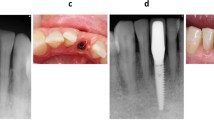Abstract
Rehabilitation of the atrophic maxilla is always a major surgical challenge. The premature loss of maxillary molars usually leads to a pronounced atrophy of the maxillary alveolar ridge [1]. In a few cases the frontal bone was so thin that two diameter-reduced 3.0 × 8.0 mm locking taper calcium phosphate-coated Integra CP™ Bicon implants were used [2]. Irrespective of this, in extraordinarily complex cases we have observed that the options for augmentation reconstructions and implant application in the anterior maxilla are extremely limited due to the lack of alveolar ridge height and width. For this reason, we are treating with three 4.0 × 5.0 mm ultrashort or 4.5 × 6.0 mm, respectively, 5.0 × 6.0 mm short locking taper calcium phosphate-coated Integra CP™ implants from Bicon (Boston/USA) in the atrophic maxilla [3]. A preoperative DVT is essential in order to decide whether it is possible to insert an implant though the incisal foramen and into the nasopalatine canal [4, 5]. The middle implant is inserted into the incisal foramen and the nasopalatine canal [6]. The incisal foramen provides the thickest and highest bone structure in the atrophic maxilla for implant placement. In the one-chambered incisal foramen, there are often two incisal nerves [7, 8]. Nerve and vascular structures usually need to be severed in a Le Fort I osteotomy [9] and horseshoe Le Fort I osteotomy [10, 11]. Concerns have repeatedly been raised about sensitivity disorders with implant insertions. In a large-scale systematic review and meta-analysis, de Mello et al. [12] filtered 10 out of 238 articles and found a success rate of 84.6% to 100% for a total of 91 implants placed in the incisal foramen. Regarding permanent nerve disorders, all 10 articles reported only one permanent nerve disorder following lateralization. The implant-supported screw-retained prosthetic constructions were provided with a 12-unit bridge made from metal-free fiberglass-reinforced hybrid resin material (TRINIA™/Bicon).
Access this chapter
Tax calculation will be finalised at checkout
Purchases are for personal use only
Similar content being viewed by others
References
Wagner F, Dvorak D, Nemec S, Pietschmann P, Figl M, Seemann R. A principal components analysis: how pneumatization and edentulism contribute to maxillary atrophy. Oral Dis. 2017;23:55–6.
Wagner F, Seemann R, Marincola M, Ewers R. Fixed, fiber-reinforced resin bridges on four short implants in severely atrophic maxillae: 1-year results of a prospective cohort study. J Oral Maxillofac Surg. 2018;76(6):1194–9; Epub 2018 Feb 19.
Ewers R. The incisal foramen as a means of insertion for one of three ultra-short implants to support a prosthesis for a severely atrophic maxilla - a short-term report. Heliyon. 2018;4(12):e01034. https://doi.org/10.1016/j.heliyon.2018.e01034; eCollection 2018 Dec.
Al-Amery S, Nambiar P, Jamaludin M, John NW. Cone beam computed tomography assessment of the maxillary incisive canal and foramen: considerations of anatomical variations when placing immediate implants. PLoS One. 2015;10(2):e0117251.
Friedrich RE, Laumann F, Zrnc T, Assaf AT. The nasopalatine canal in adults on cone beam computed tomograms-A clinical study and review of the literature. In Vivo. 2015;29(4):467–86.
Ewers R. Reduzierte Implantatzahl - auch bei kurzen Implantaten? Vortrag auf dem 13 in: Experten Symposium des BDIZ EDI Köln am 11. 2018.
Leboucq H. Le canal nasopalatin chez l’homme. Arch Biol Paris. 1881;2:386–97.
Allard RH, de Vries K, van der Kwast WA. Persisting bilateral nasopalatine ducts: a developmental anomaly. Oral Surg Oral Med Oral Pathol. 1982;53:24–6.
Bell WH. Revascularization and bone healing after anterior maxillary osteotomy: a study using adult rhesus monkeys. J Oral Surg. 1969 Apr;27(4):249–55.
Härle F, Ewers R. Die Hufeisenosteotomie mit Knocheninterposition zur Erhöhung des Oberkiefer-kammes - eine im Experiment steckengebliebene Operationsmethode. Dtsch Zahnärztl Z. 1980;35:105–7.
Yerit KC, Posch M, Guserl U, Turhani D, Schopper C, Wanschitz F, Wagner A, Watzinger F, Ewers R. Rehabilitation of the severely atrophied maxilla by horseshoe Le Fort I osteotomy (HLFO). Oral Surg Oral Med Oral Pathol Oral Radiol Endod. 2004;97:683–92.
de Mello JS, Faot F, Correa G, Chagas Júnior OL. Success rate and complications associated with dental implants in the incisive canal region: a systematic review. Int J Oral Maxillofac Surg. 2017;46:1584–91.
Peyer B. Goethes Wirbeltheorie des Schädels. In: Neujahrsblatt herausgegeben von der Naturforschenden Gesellschaft in Zürich auf das Jahr, vol. 152. Zürich: Fretz AG; 1950.
Ewers R, Marincola M, Perpetuini P. Treating the atrophic maxilla with four, three or even one ultrashort implant. J Dent Sci Oral Maxillofac Res. 2021;3:43–58. https://ologyjournals.com/jdsomr/jdsomr_00046.pdf
Benyi A. A Heron-type formula for the triangle. Math Gazette. 2003;87:324–6.
Ewers R, Fahrenholz H, Reichwein A, Gerschütz R, et al. Vorstellung des Camlog Guide Systems mit Live-Telenavigation nach Wien anlässlich des 1. Internationalen CAMLOG-Kongresses am 11. Mai 2006 in Montreux/Schweiz.
Cawood JI, Howell RA. A classification of the edentulous jaws. Int J Oral Maxillofac Surg. 1988;17:232–6.
Author information
Authors and Affiliations
Corresponding author
Editor information
Editors and Affiliations
Rights and permissions
Copyright information
© 2023 The Author(s), under exclusive license to Springer Nature Switzerland AG
About this chapter
Cite this chapter
Ewers, R., Truppe, M., Tomasetti, B.J. (2023). Clinical Case N° 19: Short Implants, Incisal Foramen, Trio-Trinia. In: Rinaldi, M. (eds) Implants and Oral Rehabilitation of the Atrophic Maxilla. Springer, Cham. https://doi.org/10.1007/978-3-031-12755-7_31
Download citation
DOI: https://doi.org/10.1007/978-3-031-12755-7_31
Published:
Publisher Name: Springer, Cham
Print ISBN: 978-3-031-12754-0
Online ISBN: 978-3-031-12755-7
eBook Packages: MedicineMedicine (R0)




